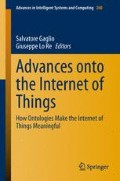Abstract
A gait analysis technique to model user presences in an office scenario is presented in this chapter. In contrast with other approaches, we use unobtrusive sensors, i.e., an array of Kinect devices, to detect some features of interest. In particular, the position and the spatio-temporal evolution of some skeletal joints are used to define a set of gait features, which can be either static (e.g., person height) or dynamic (e.g., gait cycle duration). Data captured by multiple Kinects is merged to detect dynamic features in a longer walk sequence. The approach proposed here was been evaluated by using three classifiers (SVM, KNN, Naive Bayes) on different feature subsets.
Access this chapter
Tax calculation will be finalised at checkout
Purchases are for personal use only
References
Arlot, S., Celisse, A.: A survey of cross-validation procedures for model selection. Stat. Surv. 4, 40–79 (2010)
consortium, O.: OpenNI. http://www.openni.org/
Cottone, P., Lo Re, G., Maida, G., Morana, M.: Motion sensors for activity recognition in an ambient-intelligence scenario. In: IEEE International Conference on Pervasive Computing and Communications Workshops (PerCom Workshops), pp. 646–651 (2013). doi:10.1109/PerComW.2013.6529573
Cover, T., Hart, P.: Nearest neighbor pattern classification. IEEE Trans. Inf. Theory 13(1), 21–27 (1967)
Cutting, J.E., Kozlowski, L.T.: Recognizing friends by their walk: gait perception without familiarity cues. Bull. Psychon. Soc. 9(5), 353–356 (1977)
De Paola, A., Gaglio, S., Lo Re, G., Ortolani, M.: Sensor9k : A testbed for designing and experimenting with wsn-based ambient intelligence applications. Pervasive Mob. Comput. 8(3), 448–466 (2012). http://dx.doi.org/10.1016/j.pmcj.2011.02.006
De Paola, A., La Cascia, M., Lo Re, G., Morana, M., Ortolani, M.: User detection through multi-sensor fusion in an ami scenario. In: Information Fusion (FUSION), pp. 2502–2509 (2012)
De Paola, A., La Cascia, M., Lo Re, G., Morana, M., Ortolani, M.: Mimicking biological mechanisms for sensory information fusion. Biol. Inspired Cogn. Architectures 3(0), 27–38 (2013). doi:10.1016/j.bica.2012.09.002. http://www.sciencedirect.com/science/article/pii/S2212683X12000527
Gafurov, D.: A survey of biometric gait recognition: approaches, security and challenges. In: Annual Norwegian Computer Science Conference, pp. 19–21 (2007)
Gruber, T.R., et al.: A translation approach to portable ontology specifications. Knowl. Acquisition 5(2), 199–220 (1993)
Han, J., Bhanu, B.: Individual recognition using gait energy image. IEEE Trans. Pattern Anal. Mach. Intell. 28(2), 316–322 (2006)
Lee, L., Grimson, W.E.L.: Gait analysis for recognition and classification. In: Proceedings of Fifth IEEE International Conference on Automatic Face and Gesture Recognition, pp. 148–155 (2002)
Liu, Z., Sarkar, S.: Simplest representation yet for gait recognition: averaged silhouette. In: Proceedings of the Seventeenth International Conference on Pattern Recognition (ICPR’04), vol. 4, pp. 211–214 (2004)
Lo Re, G., Morana, M., Ortolani, M.: Improving user experience via motion sensors in an ambient intelligence scenario. In: Pervasive and Embedded Computing and Communication Systems (PECCS), pp. 29–34 (2013)
Middleton, L., Buss, A., Bazin, A., Nixon, M.: A floor sensor system for gait recognition. In: Fourth IEEE Workshop on Automatic Identification Advanced Technologies, pp. 171–176 (2005). doi:10.1109/AUTOID.2005.2
Murray, M.P., Drought, A.B., Kory, R.C.: Walking patterns of normal men. J. Bone Joint Surg. 46(2), 335–360 (1964)
Orr, R.J., Abowd, G.D.: The smart floor: a mechanism for natural user identification and tracking. In: CHI’00 Extended Abstracts on Human Factors in Computing Systems, pp. 275–276. ACM Press (2000)
Preis, J., Kessel, M., Werner, M., Linnhoff-Popien, C.: Gait recognition with kinect. In: Proceedings of the First International Workshop on Kinect in Pervasive Computing (2012)
Scholkopf, B., Smola, A.J.: Learning with Kernels: Support Vector Machines, Regularization, Optimization, and Beyond. MIT Press, Cambridge (2001)
Shakhnarovich, G., Lee, L., Darrell, T.: Integrated face and gait recognition from multiple views. In: Proceedings of IEEE Conference on Computer Vision and Pattern Recognition, vol. 1, pp. 436–439 (2001)
Sivapalan, S., Chen, D., Denman, S., Sridharan, S., Fookes, C.: Gait energy volumes and frontal gait recognition using depth images. In: IEEE International Joint Conference on Biometrics (IJCB), pp. 1–6 (2011)
Tao, D., Li, X., Wu, X., Maybank, S.J.: General tensor discriminant analysis and gabor features for gait recognition. IEEE Trans. Pattern Anal. Mach. Intell. 29(10), 1700–1715 (2007)
Wang, J., She, M., Nahavandi, S., Kouzani, A.: A review of vision-based gait recognition methods for human identification. In: Digital Image Computing Techniques and Applications (DICTA), pp. 320–327 (2010)
Wang, L., Tan, T., Hu, W., Ning, H.: Automatic gait recognition based on statistical shape analysis. IEEE Trans. Image Proc. 12(9), 1120–1131 (2003)
Wang, L., Tan, T., Ning, H., Hu, W.: Silhouette analysis-based gait recognition for human identification. IEEE Trans. Pattern Anal. Mach. Intell. 25(12), 1505–1518 (2003)
Yamauchi, K., Bhanu, B., Saito, H.: Recognition of walking humans in 3d: initial results. In: Proceedings of the IEEE Computer Society Conference on Computer Vision and Pattern Recognition Workshops (CVPR), pp. 45–52 (2009)
Zhang, H.: The optimality of naive bayes. In: Proceedings of the Seventeenth International Florida Artificial Intelligence Research Society Conference (2004)
Acknowledgments
This work has been partially supported by the PO FESR 2007/2013 grant G73F11000130004 funding the SmartBuildings project.
Author information
Authors and Affiliations
Corresponding author
Editor information
Editors and Affiliations
Rights and permissions
Copyright information
© 2014 Springer International Publishing Switzerland
About this chapter
Cite this chapter
Maida, G., Morana, M. (2014). Gait Analysis Using Multiple Kinect Sensors. In: Gaglio, S., Lo Re, G. (eds) Advances onto the Internet of Things. Advances in Intelligent Systems and Computing, vol 260. Springer, Cham. https://doi.org/10.1007/978-3-319-03992-3_12
Download citation
DOI: https://doi.org/10.1007/978-3-319-03992-3_12
Published:
Publisher Name: Springer, Cham
Print ISBN: 978-3-319-03991-6
Online ISBN: 978-3-319-03992-3
eBook Packages: EngineeringEngineering (R0)

